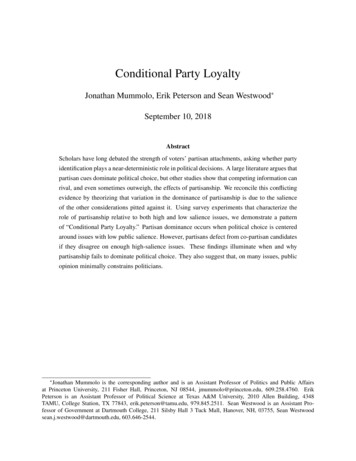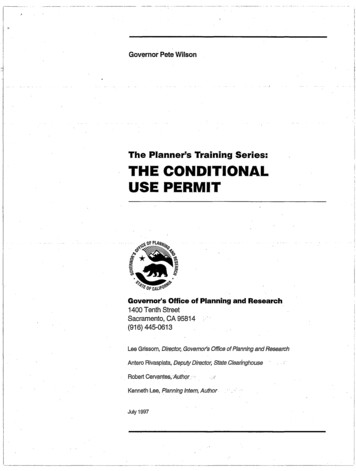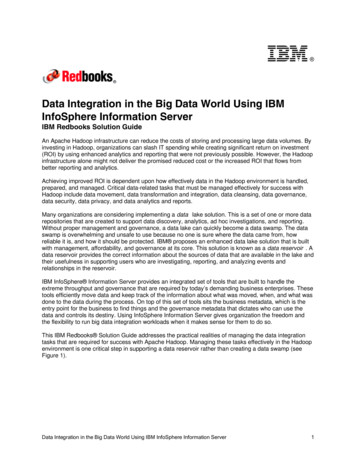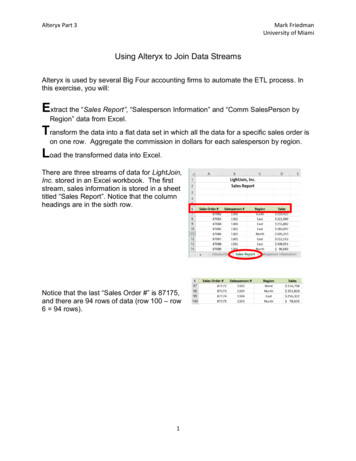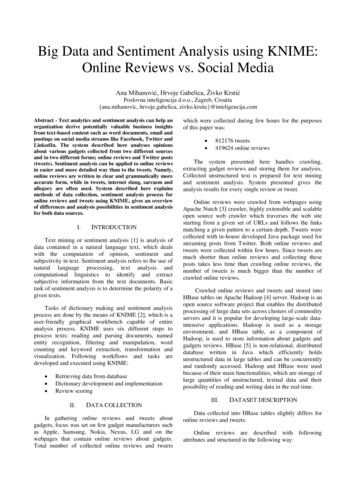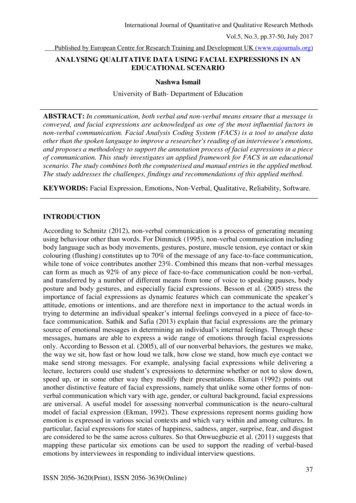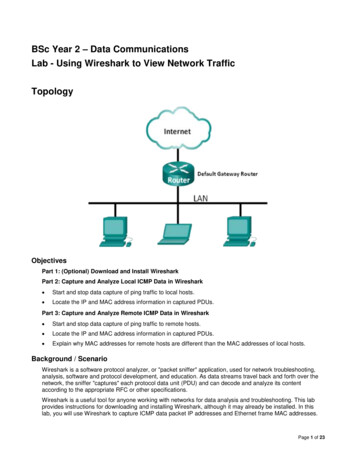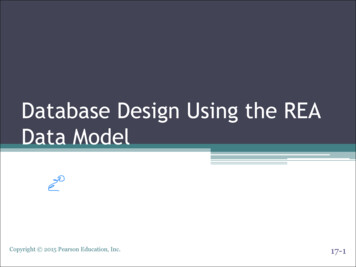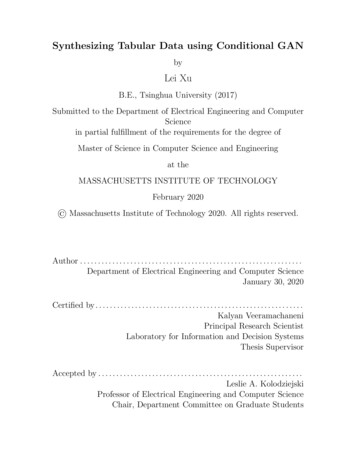
Transcription
Synthesizing Tabular Data using Conditional GANbyLei XuB.E., Tsinghua University (2017)Submitted to the Department of Electrical Engineering and ComputerSciencein partial fulfillment of the requirements for the degree ofMaster of Science in Computer Science and Engineeringat theMASSACHUSETTS INSTITUTE OF TECHNOLOGYFebruary 2020 Massachusetts Institute of Technology 2020. All rights reserved.Author . . . . . . . . . . . . . . . . . . . . . . . . . . . . . . . . . . . . . . . . . . . . . . . . . . . . . . . . . . . . . .Department of Electrical Engineering and Computer ScienceJanuary 30, 2020Certified by . . . . . . . . . . . . . . . . . . . . . . . . . . . . . . . . . . . . . . . . . . . . . . . . . . . . . . . . . .Kalyan VeeramachaneniPrincipal Research ScientistLaboratory for Information and Decision SystemsThesis SupervisorAccepted by . . . . . . . . . . . . . . . . . . . . . . . . . . . . . . . . . . . . . . . . . . . . . . . . . . . . . . . . .Leslie A. KolodziejskiProfessor of Electrical Engineering and Computer ScienceChair, Department Committee on Graduate Students
2
Synthesizing Tabular Data using Conditional GANbyLei XuSubmitted to the Department of Electrical Engineering and Computer Scienceon January 30, 2020, in partial fulfillment of therequirements for the degree ofMaster of Science in Computer Science and EngineeringAbstractIn data science, the ability to model the distribution of rows in tabular data andgenerate realistic synthetic data enables various important applications including datacompression, data disclosure, and privacy-preserving machine learning. However,because tabular data usually contains a mix of discrete and continuous columns,building such a model is a non-trivial task. Continuous columns may have multiplemodes, while discrete columns are sometimes imbalanced, making modeling difficult.To address this problem, I took two major steps.(1) I designed SDGym, a thorough benchmark, to compare existing models, identifydifferent properties of tabular data and analyze how these properties challenge different models. Our experimental results show that statistical models, such as Bayesiannetworks, that are constrained to a fixed family of available distributions cannotmodel tabular data effectively, especially when both continuous and discrete columnsare included. Recently proposed deep generative models are capable of modelingmore sophisticated distributions, but cannot outperform Bayesian network models inpractice, because the network structure and learning procedure are not optimized fortabular data which may contain non-Gaussian continuous columns and imbalanceddiscrete columns.(2) To address these problems, I designed CTGAN, which uses a conditional generative adversarial network to address the challenges in modeling tabular data. BecauseCTGAN uses reversible data transformations and is trained by re-sampling the data, itcan address common challenges in synthetic data generation. I evaluated CTGAN onthe benchmark and showed that it consistently and significantly outperforms existingstatistical and deep learning models.Thesis Supervisor: Kalyan VeeramachaneniTitle: Principal Research ScientistLaboratory for Information and Decision Systems3
4
AcknowledgmentsForemost, I would like to thank my advisor, Dr. Kalyan Veeramachaneni for thecontinuous support of my study and research, for his patience, motivation, enthusiasm, and immense knowledge. I would like to thank all members in the Data to AILab for inspiring discussion. During this research project, Carles Sala helped withmaintaining the GitHub repo; Cara Giaimo helped with text editing; Arash Akhgarihelped with figure design; I would like to thank them for their contribution and help.Finally, I would like to thank my family and friends who have been supported me allthe time.5
6
Contents1 Introduction1.115Tabular data in different domains . . . . . . . . . . . . . . . . . . . .151.1.1Recommender systems . . . . . . . . . . . . . . . . . . . . . .161.1.2Healthcare . . . . . . . . . . . . . . . . . . . . . . . . . . . . .181.1.3Data storage and disclosure . . . . . . . . . . . . . . . . . . .191.2Necessity of synthetic data . . . . . . . . . . . . . . . . . . . . . . . .201.3Types of synthetic data generators . . . . . . . . . . . . . . . . . . .221.4Existing generation-based methods . . . . . . . . . . . . . . . . . . .231.5An overview of this research . . . . . . . . . . . . . . . . . . . . . . .242 Primer on Generative Models272.1Variational autoencoders . . . . . . . . . . . . . . . . . . . . . . . . .272.2Generative adversarial networks . . . . . . . . . . . . . . . . . . . . .293 Synthetic Data Generation Task and Related Work353.1Synthetic data generation . . . . . . . . . . . . . . . . . . . . . . . .353.2Existing techniques to generate synthetic data . . . . . . . . . . . . .373.2.1PrivBayes . . . . . . . . . . . . . . . . . . . . . . . . . . . . .383.2.2MedGAN . . . . . . . . . . . . . . . . . . . . . . . . . . . . .403.2.3TableGAN . . . . . . . . . . . . . . . . . . . . . . . . . . . . .413.2.4VeeGAN . . . . . . . . . . . . . . . . . . . . . . . . . . . . . .424 Challenges of Modeling Tabular Data using GAN747
4.1Challenges on single-table non-time-series data . . . . . . . . . . . . .474.2Challenges on time-series data . . . . . . . . . . . . . . . . . . . . . .514.3Challenges on multiple table data . . . . . . . . . . . . . . . . . . . .515 Conditional Tabular GAN535.1Notations . . . . . . . . . . . . . . . . . . . . . . . . . . . . . . . . .535.2Mode-specific normalization . . . . . . . . . . . . . . . . . . . . . . .535.3Conditional tabular GAN architecture . . . . . . . . . . . . . . . . .566 Other Methods for Synthetic Data Generation636.1TGAN . . . . . . . . . . . . . . . . . . . . . . . . . . . . . . . . . . .636.2Tabular VAE . . . . . . . . . . . . . . . . . . . . . . . . . . . . . . .667 SDGym Benchmark Framework697.1Simulated data . . . . . . . . . . . . . . . . . . . . . . . . . . . . . .707.2Real data . . . . . . . . . . . . . . . . . . . . . . . . . . . . . . . . .718 Experiment Results758.1Settings and hyperparameters . . . . . . . . . . . . . . . . . . . . . .758.2Quantitative results . . . . . . . . . . . . . . . . . . . . . . . . . . . .768.3Case analysis . . . . . . . . . . . . . . . . . . . . . . . . . . . . . . .798.4Ablation study . . . . . . . . . . . . . . . . . . . . . . . . . . . . . .808.5Discussion . . . . . . . . . . . . . . . . . . . . . . . . . . . . . . . . .819 Conclusion and Future Work83A Notations85B Figures878
List of Figures3-1 The MedGAN framework contains an encoder, a decoder, a generator,and a discriminator. The encoder and decoder are pretrained on thereal data and fixed in later steps. During training, the output of thegenerator is passed through the decoder before feeding into the discriminator. The discriminator checks whether the data are real or fake. 413-2 VeeGAN framework. VeeGAN contains three modules: a generator, adiscriminator, and a reconstructor. The top section shows the workflowstarting from random noise z. In this workflow, the generator projects zto synthetic data x0 and tries to fool the discriminator. The gradientsfrom the discriminator help the generator improve. Meanwhile, thereconstructor learns to project x0 back to z r z. The bottom sectionshows the workflow starting from real data x. x is inputted to thereconstructor in order to generate a representation vector z 0 . Then realtuples (x, z 0 ) and fake tuples (x0 , z) are used to train the discriminator.443-3 The reconstructor makes a connection between missing modes and existing modes, so that the generator can recover from mode collapse.The left section shows how the generator projects random noise intothe data space. The right section shows how the reconstructor projectsdata into the noise space. . . . . . . . . . . . . . . . . . . . . . . .945
4-1 Challenges of non-Gaussian distribution on GAN models. Assume wehave a non-Gaussian continuous column with a few large outliers. Thelarge outliers squeeze all other values towards -1. After min-max normalization, the probability density looks like (A). To use a neural network with tanh activation to generate this column, the probabilitydistribution of values before the tanh activation looks like (B). Thegradient of tanh vanishes in this range, as shown in (C). The modelcan not learn effectively with a vanished gradient. . . . . . . . . .484-2 [50] show that a vanilla GAN can not model a simple 2-dimensionalGaussian mixture. (A) is the probability density of 25 Gaussian distributions aligned as a grid. (B) is the corresponding distribution learnedby GAN. (C) is the original distribution and (D) is the correspondingdistribution learned by GAN. . . . . . . . . . . . . . . . . . . . . . .495-1 An example of mode-specific normalization. The distribution of a continuous column (the blue dashed line in the left figure) has 3 modes,and these modes are modeled by a variational Gaussian mixture model.In the middle figure, a value from that column ci,j appears. ci,j has theprobability density of ρ1 , ρ2 , ρ3 of coming from each mode. It is morelikely to come from the third mode. So ci,j is normalized by the meanand standard deviation of the third mode, namely η3 and φ3 . . . .555-2 CTGAN structure. . . . . . . . . . . . . . . . . . . . . . . . . . . . . . .576-1 Example of using TGAN generator to generate a simple table. Theexample has two continuous variables and two discrete variables. Theorder of these columns is [C1 , D1 , C2 , D2 ]. TGAN generates these fourvariables one by one following their original order in the table. Eachsample is generated in six steps. Each numerical variable is generatedin two steps while each categorical variable is generated in one step.6-2 TVAE structure. . . . . . . . . . . . . . . . . . . . . . . . . . . . . .106468
7-1 Evaluate synthetic data generator using simulated data.7-2 Real data in synthetic data generator benchmark. . . . . . .71. . . . . . . . . .728-1 Visualize synthesized grid data set using TableGAN, VEEGAN, TVAE andCTGAN. The red marks are the ground truth modes and the blue dotsare synthetic samples generated by different synthesizers. . . . . .798-2 Visualize synthesized gridr data set using TVAE and CTGAN. The redmarks are the ground truth modes and the blue dots are syntheticsamples generated by different synthesizers. . . . . . . . . . . . . .80B-1 Visualize grid (left), gridr (middle) and ring (right) datasets. Eachblue point represents a row in a table. The x-axis and y-axis representthe value of two continuous columns respectively. The red ‘x’s in theplots are the modes for Gaussian mixtures. . . . . . . . . . . . . . . .87B-2 Bayesian network structures of asia (left) and alarm (right) datasets.88B-3 Bayesian network structures of child (left) and insurance (right)datasets. . . . . . . . . . . . . . . . . . . . . . . . . . . . . . . . . . .1188
12
List of Tables1.1Data-related issues to address in different domains. . . . . . . . . . .4.1A summary showing whether existing methods and our CTGAN explicitly20address the aforementioned challenges [C1 - C8]. ( indicates it is ableto model continuous and binary.) . . . . . . . . . . . . . . . . . . . .7.151Simulated datasets in our benchmark. #C, #B, and #M mean number of continuous columns, binary columns and multi-class discretecolumns respectively.7.2. . . . . . . . . . . . . . . . . . . . . . . . . .71Real datasets in our benchmark. #C, #B, and #M mean number ofcontinuous columns, binary columns and multi-class discrete columnsrespectively.7.3. . . . . . . . . . . . . . . . . . . . . . . . . . . . . . .73Classifiers and regressors selected for each real dataset and corresponding performance. . . . . . . . . . . . . . . . . . . . . . . . . . . . . .738.1Benchmark results on Gaussian mixture simulated data. . . . . . . .778.2Benchmark results on Bayesian network simulated data. . . . . . . . .778.3Benchmark results on real data. . . . . . . . . . . . . . . . . . . .788.4Distance between synthetic data and nearest neighbor in training set.788.5Classification performance of different classifers. . . . . . . . . . . . .798.6Ablation study on mode-specific normalization. . . . . . . . . . . . .818.7Ablation study on training-by-sampling and conditional vector. . . . .818.8Ablation study on Wasserstein GAN and PacGAN. . . . . . . . . . .81A.1 Notations . . . . . . . . . . . . . . . . . . . . . . . . . . . . . . . . .8613
14
Chapter 1IntroductionTabular data is one of the most common and important data modalities [1]. Massiveamounts of data, including census results, health care records, and web logs (generatedfrom human interaction with websites) are all stored in tabular format. Such datais valuable because it contains useful patterns that can help in decision-making. Asmore and more companies, policymakers, and research institutes rely on data tomake decisions, people have recognized the need to enable good decision-making andensure privacy protection, as well as manage other issues. It is in this context thatthe demand for synthetic data arises.1.1Tabular data in different domainsTabular data is widely used in different fields and has become an integral part ofpredicting potential needs. Every day when we open YouTube, our favorite videosare already queued up and can be viewed with just one click, without the need fortedious searches. Data can be used to predict the risk of disease and provide peoplewith life and medical advice. Data can also help governments and companies makedecisions. The growth of the field is exponential, as the availability of massive datainspires people to explore different applications.However, due to the quality, quantity, and privacy issues associated with usingreal data, people usually do not stick to the original data when creating and exploring15
these applications in various domains. We give examples within several representativedomains to show how issues with real data motivate the need for synthetic data.1.1.1Recommender systemsTo this day, as long as we use the Internet, we will inevitably be affected by therecommender system. A recommender system is one of the most profitable use casesfor tabular data, and has enabled companies like Amazon and Google to grow to atrillion-dollar market cap. Taking movie recommendation as an example, we introducehow recommender systems are built, and the issues that arise and motivate the needfor synthetic data generation methods.Movie recommendation is a well-studied example in machine learning and datascience due to the availability of datasets like MovieLens [19] and Netflix [6]. Themethods verified on movie recommendation problems are also applied in other scenarios, such as product recommendations on Amazon [37, 24].– Early content-based recommender systems [2] use movie descriptions and userprofiles to make recommendations. For example, if a user is interested in aparticular actor, the recommender system will recommend all the movies fromthat actor. To build a content-based recommender system requires a table ofmovie metadata, such as the directors, cast, and genres, and a table of users’watch history. In the training phase, users’ watch histories are used to identifythe users’ interests and construct user profiles. For example, if a user watcheshorror movies more frequently than average, the horror tag will be added to theprofile. In the inference phase, movies related to the profile are recommendedto the user.Content-based methods require high-quality metadata. Before training themodel, metadata are constructed manually to ensure quality. Recently, contentbased methods have been replaced by collaborative filtering methods due totheir superior performance.– Collaborative filtering [47] is a common method used in recommender systems.16
Collaborative filtering methods start with a user-item matrix M . Each row ofM represents all the movies the user likes. An entry in a row is 1 if the user likesthe movie, and 0 otherwise. Then M is factorized to a low-rank user matrix Uand a low-rank movie matrix V where M U V T . The interest level of useri to movie j is the inner product of the user vector and movie vector Ui VjT ,and recommendations are then made according to the interest level. To train acollaborative filtering model requires only a table of users’ watch history.When building models this way, the following data issues arise. The quantity issue: Collaborative filtering will give superior performance only whenthe scale of the dataset is large. To overcome small datasets, people generatelarge synthetic datasets. For example, to generate synthetic data from MovieLens [19], people expand each real user into several similar fake users.1 Thequality issue: Expanding the dataset is not necessary for an industry-scalesystem, because the quantity of training data is usually not an issue for companies. Instead, their main issue is data quality. Users’ watch history is noisybecause watching a movie does not necessarily indicate that the user likes thatmovie. To tackle this, [35] filters the training data using users’ ratings. Themovies that are rated low are taken out. Filtering is also done on users. Userswith very few watched movies tend to provide a noisy signal in the training, so[21] filters out users with less than 20 watched movies. The imbalance issue:Furthermore, the data distribution is highly imbalanced. For example, becausethere are far fewer Chinese movies than English movies on most platforms, theirmodels perform worse when it comes to recommending those movies. This holdstrue across minorities. [38, 34] split the dataset into smaller datasets and trainlocal models to address these issues. The privacy issue: It is also important to note that in large-capacity models2 , the model can remember a lot ofinformation, including users’ personal information. This presents the risk of1The code to generate synthetic MovieLens data from real data is available online. a generation2Collaborative filtering methods have lots of parameters. A typical setup uses 50 to 500 dimensional vectors to represent users and movies.17
leaking sensitive user information. For example, Netflix’s publicly available recommendation data set can be used to identify individuals and determine sexualorientation, and has been prosecuted [49]. [22, 52] uses gated-recurrent networks and transformers to make sequential recommendations. In these models, the prediction task is to predict what someonewill watch next, using their watch history as a sequence. These models performbetter than collaborative filtering because they consider sequential information.For example, when a user watches Avengers I and II successively, he is likely towatch Avengers III next. A sequential recommender can capture this pattern,while collaborative filtering can not. To train a sequential recommender systemrequires a table of users’ watch history with timestamps.The privacy issue: The parameters in these models are even larger than thosein collaborative filtering models. These models are also highly non-linear andcan remember various patterns, which increases the risk of a privacy breach.Using tabular data to train a recommender system involves data quality, dataimbalance, and data privacy issues. Data quality can be improved by applying variousfiltering criteria to the data. Data imbalance can be addressed by partitioning thedata and learning of local models. Addressing the privacy issue is more challenging.1.1.2HealthcareBig data is also used in the medical field to make diagnoses more accurate and efficient. Data can be used to predict whether a patient will show up for an appointment [3], to help the hospital improve time management and resource use. Data can also be used to determine whether a patient has a certain disease, suchas heart disease, pneumonia, etc. This is a critical application. Due to issueswith medical data, the robustness and fairness of these models are questioned.Collecting medical data requires the involvement of specialized doctors, leadingto a high collection cost and data. [16] uses data augmentation to increase18
the size of a medical dataset. Medical data may also be noisy, and doctors’wrong judgments can introduce errors into the data. In addition, it suffers fromdata imbalance — [12] shows that the imbalanced medical data leads to unfairpredictions. Medical data also contains a large amount of personal information,which can easily identify individuals and infringe on people’s privacy. Wearables also collect large amounts of data and can provide suggestions meantto improve people’s health. For example, [46] uses wearables to track people’ssleeping conditions. Data collected by wearables, which can include location,sound, or even images, are extremely sensitive and should not leave the device.People design algorithms [8, 28] to train machine learning models on this datawithout sending it to a central server.Machine learning systems that use healthcare data deal with very sensitive information and make critical decisions. The quantity, quality, imbalance, and privacy ofthis data should be handled seriously.1.1.3Data storage and disclosureSometimes, tabular data is simply constructed by a website or gathered by surveyorsand is then either stored in a database, used to complete website business, or releasedby a statistics bureau. This data may not require the use of machine learning foranalysis in the short term, but privacy issues will still be encountered during theprocess of construction, storage, and distribution. Every few years, the National Bureau of Statistics conducts a census, and theresults of the census are published online. This data is helpful for solving socialproblems, but the direct publication of accurate census data is likely to violatecitizens’ privacy. If only statistical data is published instead of data for eachindividual, the value of the data for research will decrease. As a result, peoplehave invested a lot of time in resolving the issue of census data while protectingprivacy. Some researchers in the statistical science community have begun using19
randomization-based methods to perturb sensitive columns in tabular data [44,42, 43, 32]. Another scenario involves data storage and use within a company. When usersinteract with a company website, a large number of records are generated inthat company’s database. Users may also fill in personal information suchas addresses, credit card numbers, preferences, etc. This information must bestrictly confidential in accordance with the General Data Protection Regulation(GDPR). However, inside the company, engineers will have software development and bug fix requirements that require data use. Companies do not wanttheir employees to have access to real user data, as this would violate userprivacy, so actions need to be taken to prevent insiders from reading sensitiveinformation. At Uber, for example, a system is deployed so that employees canonly access perturbed customer data [29]. Prior to deploying the system, Uberreportedly mishandled customer data, allowing employees to gain unauthorizedaccess [20].1.2Necessity of synthetic dataTable 1.1: Data-related issues to address in different domains.Recommender SystemHealthcareData XXXDespite the huge investment institutions put into collecting tabular data everyday, real tabular data cannot always fulfill what is asked of it. Table 1.1 summarizesdata-related issues that arise in different domains.– The quantity issue: In certain areas, insufficient data is an issue. Especiallyif the acquisition of data requires a person with specialized skills, such as in themedical field, the amount of data and the cost of acquiring the data will become20
a problem. If real data can be supplemented and enhanced using synthetic data,then less existing data can be used to achieve more valuable applications.– The quality issue: Data quality issues are common. During the data collectionprocess, various factors can affect the quality of the data — for example, missingvalues and outliers from people incorrectly filling in a questionnaire. Learningthe distribution of the data and repairing and enhancing the data can reducethe impacts of this problem.– The imbalance issue: Data imbalance is the normal state of tabular data,as tables usually have major and minor categories. Imbalance causes a lot ofproblems when developing models. Using synthetic data to supplementing theniche data in a table can solve this problem.– The privacy issue: Furthermore, most tabular data contains sensitive information that could be used to identify individuals and intrude on their privacy.Data containing sensitive information tends to be strictly protected and out ofreach of researchers. If synthetic data can preserve correlations in a table butremove all sensitive information, it could be used to remove this barrier to datadisclosure.Applications of Synthetic Data High-quality synthetic data has importantapplications:– Data understanding: Learning the distribution of tabular data can help usunderstand the underlying structure and association between columns.– Data compression: Synthetic data generators can be used to store tabulardata efficiently and compactly. A small generative neural network can be easilystored on portable devices to generate an infinite number of rows.– Data augmentation: A generative model can generate (more) training data,or reasonably perturb the original data, which can improve the performance ofdownstream predictive models.21
– System testing: Synthetic datasets that are derived from the same actualunderlying process as their corresponding real datasets can be used to test newsystems, as opposed to those generated from (usually) unrealistic simulatingscenarios. System testing is sometimes conducted using synthetic data in orderto protect privacy or prevent over-fitting. The use of high-quality synthetic datacan ensure similar performance in testing and production environments.– Data disclosure: Data privacy is an important issue today. Using syntheticdata instead of real data can avoid the disclosure of private information whilestill allowing data to be used for various applications.1.3Types of synthetic data generatorsSynthetic data generation is an effective way to address these quantity, quality andprivacy issues. We categorize synthetic data generation methods into two stages:– Perturbion-based methods. Methods in this category modify the values inexisting tables to fix outliers or reduce privacy leaks. These methods have beenstudied for many years. Because each row in synthetic data generated with thismethod has a corresponding row in the real data, these methods can neitherincrease the size of the data nor provide good privacy protection.– Generation-based methods. Another category of methods tries to generatesynthetic data from some distribution. This distribution could either be handcrafted or learned from data. These methods can generate an arbitrary amountof data. Under certain circumstances, privacy-protecting mechanisms can beadded to provide better privacy. Generating data with handcrafted distributions is in wide use, while synthesizing data using learned distributions is anarea of recent study.The methods in the first stage are an ad-hoc, ineffective solution to protect privacy,while methods in the second stage can systematically address quantity, quality andprivacy issues by substituting real data with synthetic data.22
1.4Existing generation-based methodsHuge efforts have been made in the field of synthesizing tabular data from existingdistributions. Both statistical methods and deep learning methods are used to learnthe distribution of real data so that synthetic data can be generated by sampling.Statistical methods use a family of the predefined probability distributions to fit anew tabular dataset. For example, a Gaussian mixture model can be used to model thejoint distribution of a few continuous columns, while Bayesian networks can be usedto model the joint distribution of discrete columns. However, because these modelsare limited by the probability distributions available, they are not general enoughfor various datasets, especially when the data has a mix of discrete and continuouscolumns. In the case of modeling survey data, where continuous columns can hardlybe avoided, people discretize continuous columns so that the data can be modeledby Bayesian networks or decision trees. Even beyond issues with model capability,training such statistical models is expensive, and these models cannot scale up tolarge-scale datasets with thousands of columns and millions of rows.Deep learning methods make up another major category of data synthesizers.The motivation for building a high-quality deep neural network for tabular datacomes from the success of such models on computer vision and natural languageprocessing. Deep generative models like variational autoencoders (VAEs) [31] andgenerative adversarial networks (GANs) [17] have two new capabilities: First, thecapacity to learn a complicated high-dimensional probability distribution, and second,the ability to draw high-quality samples from images or text. These capabilities haveenabled various important applications in vision and language [26, 59, 33, 57, 54]. Itis also possible to build similarly high-quality models to generate synthetic tabulardata — the implicit joint distribution of columns can be learned from real data, andsynthetic rows can then be sampled from that distribution. A few models have beenproposed (MedGAN [13], TableGAN [39], PATE-GAN [30]) that work by directly applyingfully connected networks or convolutional neural networks on tabular data wi
In data science, the ability to model the distribution of rows in tabular data and generate realistic synthetic data enables various important applications including data compression, data disclosure, and privacy-preserving machine learning. However, because tabular data u

